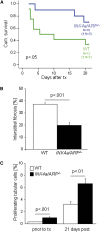Cellular senescence limits regenerative capacity and allograft survival
- PMID: 22797186
- PMCID: PMC3431409
- DOI: 10.1681/ASN.2011100967
Cellular senescence limits regenerative capacity and allograft survival
Abstract
Long-term graft survival after kidney transplantation remains unsatisfactory and unpredictable. Interstitial fibrosis and tubular atrophy are major contributors to late graft loss; features of tubular cell senescence, such as increased p16(INK4a) expression, associate with these tubulointerstitial changes, but it is unknown whether the relationship is causal. Here, loss of the INK4a locus in mice, which allows escape from p16(INK4a)-dependent senescence, significantly reduced interstitial fibrosis and tubular atrophy and associated with improved renal function, conservation of nephron mass, and transplant survival. Compared with wild-type controls, kidneys from INK4a(-/-) mice developed significantly less interstitial fibrosis and tubular atrophy after ischemia-reperfusion injury. Consistently, mice that received kidney transplants from INK4a/ARF(-/-) donors had significantly better survival 21 days after life-supporting kidney transplantation and developed less tubulointerstitial changes. This correlated with higher proliferative rates of tubular cells and significantly fewer senescent cells. Taken together, these data suggest a pathogenic role of renal cellular senescence in the development of interstitial fibrosis and tubular atrophy and kidney graft deterioration by preventing the recovery from injury. Inhibiting premature senescence could have therapeutic benefit in kidney transplantation but has to be balanced against the risks of suspending antitumor defenses.
Figures



References
-
- Lamb KE, Lodhi S, Meier-Kriesche HU: Long-term renal allograft survival in the United States: A critical reappraisal. Am J Transplant 11: 450–462, 2011 - PubMed
-
- Einecke G, Sis B, Reeve J, Mengel M, Campbell PM, Hidalgo LG, Kaplan B, Halloran PF: Antibody-mediated microcirculation injury is the major cause of late kidney transplant failure. Am J Transplant 9: 2520–2531, 2009 - PubMed
-
- Nath KA: Tubulointerstitial changes as a major determinant in the progression of renal damage. Am J Kidney Dis 20: 1–17, 1992 - PubMed
-
- Nankivell BJ, Borrows RJ, Fung CL, O’Connell PJ, Allen RD, Chapman JR: The natural history of chronic allograft nephropathy. N Engl J Med 349: 2326–2333, 2003 - PubMed
Publication types
MeSH terms
Substances
LinkOut - more resources
Full Text Sources
Other Literature Sources
Medical

